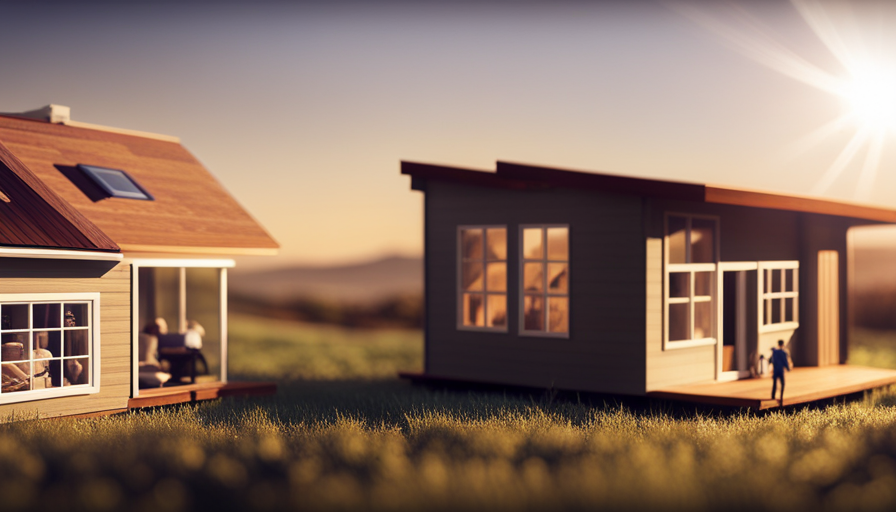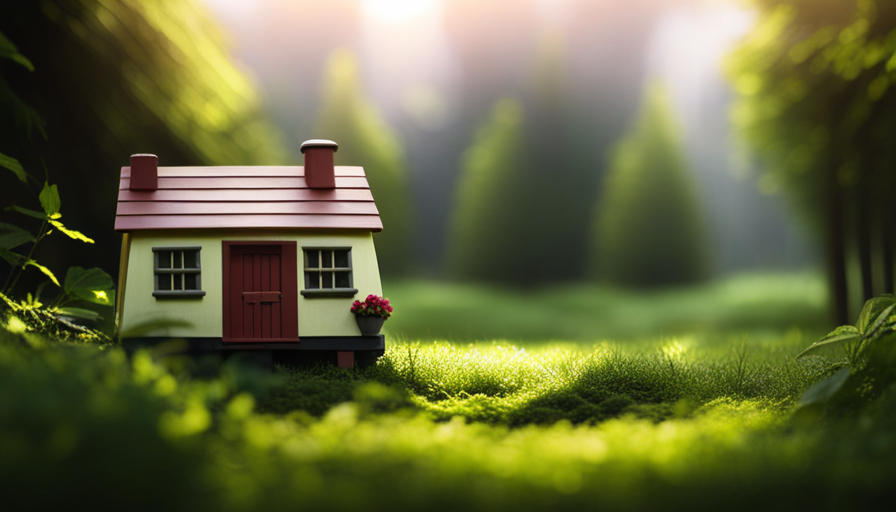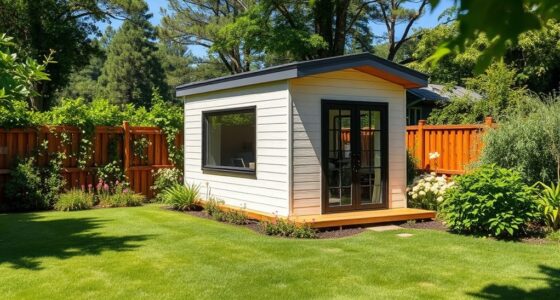In a society that often prioritizes bigger is better, a notable exception is the tiny house. Despite their small size, these compact dwellings showcase the power of creative building and innovative design, highlighting the importance of resourcefulness and environmental sustainability.
As I embark on a journey to explore what defines a tiny house, I am captivated by the paradox it presents – a small space that offers boundless possibilities.
With my pen in hand and an insatiable curiosity, I will delve into the intricate details that distinguish these diminutive abodes. From their size and square footage to their mobility and off-grid capabilities, every element is meticulously crafted to make the most of limited space. And it doesn’t stop there.
Tiny houses are also champions of environmental sustainability, showcasing how we can live harmoniously with nature. But it’s not just about functionality and efficiency; these homes offer a canvas for personalization and self-expression, making each one a unique reflection of its owner.
Join me on this captivating journey as we unravel the secrets behind these remarkable dwellings that redefine what it means to live large in a small space.
Key Takeaways
- Tiny houses challenge the notion that bigger is better and showcase innovation and sustainability.
- They maximize functionality and comfort in every square inch, utilizing vertical space and natural light.
- Tiny houses emphasize functional design and space optimization, utilizing space-saving furniture and creative storage solutions.
- They prioritize a minimalist lifestyle focused on experiences and relationships, promoting sustainability and a supportive way of life.
Size and Square Footage
If you’re considering living in a tiny house, you’ll be amazed to learn that the average size of a tiny house is around 400 square feet. The tiny house movement has gained momentum in recent years, as people embrace the idea of downsizing and living a simpler, more sustainable lifestyle. Many cities and towns have even adjusted their zoning regulations to accommodate these unique dwellings.
One of the defining features of a tiny house is its small size and efficient use of space. Every square inch is carefully designed to maximize functionality and comfort. Innovative design solutions, such as multi-purpose furniture and hidden storage, are essential in making the most of the limited square footage. Attention to detail is crucial in creating a space that feels open and inviting, despite its diminutive proportions.
Sustainability is also a key aspect of tiny house living. Many tiny houses are built using environmentally friendly materials and incorporate energy-efficient features. From solar panels to composting toilets, these homes are designed to minimize their ecological footprint. Living in a tiny house often means adopting a more minimalist lifestyle, which can lead to less consumption and waste.
As we transition into the next section about mobility and portability, it’s important to note that not all tiny houses are built on foundations. Some are designed to be easily transported, allowing homeowners to take their dwellings on the road and explore new places.
Mobility and Portability
With its ability to be easily moved and transported, a tiny dwelling offers the freedom and excitement of a nomadic lifestyle. The mobility and portability of these homes provide a range of travel options that traditional houses simply cannot match. Whether it’s hitching your tiny house to the back of a truck or loading it onto a trailer, you have the freedom to explore different places without being tied down to a permanent location. It’s like having a mobile vacation home that you can take wherever you want to go.
In terms of building codes, the compact size of tiny houses often allows them to bypass many of the regulations that larger homes must adhere to. This flexibility not only makes it easier to find a place to park your tiny house, but it also opens up opportunities for innovative design and sustainability. Many tiny homeowners incorporate eco-friendly features, such as solar panels and rainwater collection systems, into their portable homes. This focus on sustainability aligns with the growing trend of eco-conscious living and reduces the environmental impact of these dwellings.
As we transition into the next section about functional design and layout, it’s important to note that the mobility and portability of tiny houses go hand in hand with their ability to maximize every inch of space.
Functional Design and Layout
Imagine the possibilities of creating a functional and well-organized living space within the limited square footage of a compact dwelling. In the world of tiny houses, functional design and space optimization are key elements to ensure that every inch is utilized efficiently.
With a focus on attention to detail, innovative design, and sustainability, tiny house enthusiasts are constantly pushing the boundaries to create spaces that not only meet their basic needs but also provide comfort and style.
Functional design in a tiny house involves carefully planning the layout to maximize the use of space. This often means incorporating multi-purpose furniture, such as beds that can be transformed into seating areas or storage units that serve as room dividers. Every nook and cranny is considered, with built-in storage solutions and hidden compartments becoming essential features. Clever ideas like foldable tables and collapsible furniture further enhance the functionality of these small spaces.
Space optimization goes beyond just furniture placement. It involves utilizing vertical space by incorporating loft areas for sleeping or storage. Additionally, windows are strategically placed to maximize natural light and create a sense of openness. Innovative storage solutions, such as underfloor compartments or built-in shelves, help keep the space clutter-free.
Efficient use of space is not just about cramming in as much as possible. It’s about creating a harmonious balance between functionality and aesthetics. The next section will explore how tiny house owners achieve this balance by incorporating efficient use of space.
Efficient Use of Space
Get ready to discover how you can maximize every inch of your compact living space by efficiently utilizing the available space and incorporating innovative design solutions. In a tiny house, every square foot counts, so it’s crucial to make the most of the limited space. Here are some effective ways to achieve efficient use of space:
- Space-saving furniture: Opt for multi-functional furniture pieces that serve more than one purpose. For example, a sofa that can be converted into a bed or a dining table that can be folded when not in use. These clever designs help save space and provide versatility.
- Creative storage solutions: Utilize every nook and cranny by incorporating smart storage solutions. From built-in shelves and cabinets to hidden compartments under stairs, there are endless possibilities to maximize storage space. Think vertically and make use of wall-mounted shelves and hanging organizers.
- Wall beds: Install a wall bed or a Murphy bed that can be folded up during the day to create more room. This allows you to have a comfortable sleeping area without sacrificing valuable space.
- Loft spaces: Take advantage of vertical space by creating loft areas. These elevated platforms can be used as sleeping quarters or storage spaces, freeing up the main floor for other activities.
- Built-in furniture: Consider custom-built furniture that’s specifically designed to fit your tiny house. This ensures that every inch is utilized efficiently, with no wasted space.
By incorporating these space-saving furniture and creative storage solutions, you can truly optimize your tiny house living experience.
Transitioning into the subsequent section about environmental sustainability, it’s essential to consider not only the design and functionality of your tiny house but also its impact on the environment.
Environmental Sustainability
To truly embrace environmental sustainability in your compact living space, you can reduce your carbon footprint by implementing energy-efficient appliances and utilizing renewable energy sources, such as solar panels. Solar panels can decrease your electricity consumption by up to 70%. Energy efficiency is a key aspect of tiny house living, as it allows you to minimize your impact on the environment while still enjoying a comfortable lifestyle.
By choosing appliances with high energy ratings, like energy-efficient refrigerators and LED lighting, you can significantly reduce your energy consumption without sacrificing functionality.
In addition to energy efficiency, incorporating eco-friendly materials into your tiny house construction is essential. Opting for sustainable building materials, such as bamboo flooring, reclaimed wood, or recycled metal, not only reduces the environmental impact but also adds a unique touch to your living space. These materials are durable and have a lower carbon footprint compared to traditional options, making them an excellent choice for eco-conscious individuals.
By focusing on energy efficiency and eco-friendly materials, you can create a tiny house that is not only stylish and functional but also environmentally sustainable. This attention to detail and innovative design ensures that your small living space contributes positively to the planet.
As we transition into the next section about the minimalist lifestyle, it’s important to note that these sustainable choices go hand in hand with simplifying our lives and reducing our consumption.
Minimalist Lifestyle
Embracing a minimalist lifestyle allows me to prioritize experiences and relationships over material possessions, fostering a sense of contentment and fulfillment in my compact living space. Living in a tiny house has forced me to be deliberate in my choices and intentional in my design. With minimalist decor, I’ve created a space that is both functional and aesthetically pleasing.
Here are some decluttering tips that have helped me maintain a minimalist lifestyle in my tiny house:
- Start small: Begin by decluttering one area at a time, such as a closet or a drawer. This helps prevent overwhelm and lets you see progress.
- One in, one out: For every new item I bring into my tiny house, I make sure to get rid of something else. This keeps the clutter from piling up.
- Multipurpose furniture: Investing in furniture that serves multiple functions, like a sofa that can also be used as a guest bed, helps maximize the use of limited space.
In my tiny house, every item has a purpose and a designated place. This intentional approach to design not only creates a visually appealing space but also promotes a sense of calm and tranquility.
Transitioning into the subsequent section about ‘customization and personalization’, I’ve found that even within the constraints of a small living space, there are countless opportunities for creativity and individual expression.
Customization and Personalization
When it comes to making your compact living space truly your own, how can you infuse your unique personality and style without overwhelming the limited space available? The answer lies in customized features and personalized interior design. In a tiny house, every square inch counts, so it’s important to choose elements that reflect your individuality while maximizing functionality.
To help you envision the possibilities, I’ve created a table below showcasing innovative design ideas for customizing and personalizing your tiny house:
| Customized Features | Personalized Interior Design | Sustainability |
|---|---|---|
| Foldable furniture | Statement wallpaper | Solar panels |
| Hidden storage | Accent lighting | Rainwater collection system |
| Multi-purpose appliances | Colorful textiles | Composting toilet |
By incorporating these elements, you can create a space that not only reflects your style but also promotes sustainability. The attention to detail in choosing customized features and personalized interior design will make your tiny house feel like a true reflection of yourself.
As we explore the topic of cost and affordability in the subsequent section, it’s important to consider how customization and personalization can impact the overall price of a tiny house.
Cost and Affordability
Affordability is a key consideration in understanding the financial implications of customizing and personalizing a compact living space. When it comes to tiny houses, cost and affordability play a significant role in determining whether this lifestyle is feasible for individuals or families.
One of the main advantages of tiny houses is the cost benefit they offer. Compared to traditional houses, tiny houses are much more affordable to build, maintain, and operate. This is due to their smaller size, which requires fewer building materials and consumes less energy. Additionally, the innovative design of tiny houses allows for creative use of space, maximizing functionality and minimizing unnecessary expenses.
In terms of financial feasibility, tiny houses provide an excellent opportunity for individuals to achieve their housing dreams without breaking the bank. The lower cost of construction and energy consumption results in reduced monthly expenses, making it easier to pay off a mortgage or save money for other financial goals. Moreover, sustainable features such as solar panels and rainwater collection systems can further reduce utility bills and increase the overall cost savings.
Transitioning into the subsequent section about off-grid capabilities, the financial benefits of tiny houses also extend to their off-grid capabilities.
Off-Grid Capabilities
Immerse yourself in the realm of self-sufficiency as you explore the off-grid capabilities of compact living spaces. Living in a tiny house not only allows you to minimize your environmental footprint, but it also empowers you to live off-grid, relying on renewable energy sources and reducing your dependence on traditional utilities.
Here are four key ways tiny houses embrace self-sufficiency and incorporate renewable energy:
- Solar Power: Many tiny house owners harness the power of the sun by installing solar panels on their roofs. These panels generate electricity that can be used to power appliances, charge batteries, and even heat water.
- Rainwater Collection: Tiny houses often feature innovative rainwater collection systems. By capturing and storing rainwater, homeowners can reduce their reliance on traditional water sources and decrease their impact on the environment.
- Composting Toilets: Instead of traditional flush toilets, tiny houses often utilize composting toilets. These self-contained systems turn waste into compost, providing a sustainable and eco-friendly alternative to traditional sewage systems.
- Energy-Efficient Design: Tiny houses are designed with energy efficiency in mind. From well-insulated walls to strategically placed windows for natural light and ventilation, these homes maximize energy efficiency and minimize the need for artificial lighting and air conditioning.
As we delve into the social aspects of tiny house living, it’s important to consider how community plays a significant role in this lifestyle.
Community and Social Aspects
Embedded within the fabric of compact living spaces lies a vibrant community that fosters social connections and a shared sense of purpose. In the world of tiny houses, community and social aspects play a vital role in defining the lifestyle.
Living in a tiny house creates opportunities for community engagement and encourages the sharing of resources.
One of the remarkable aspects of the tiny house movement is the strong sense of community it cultivates. Tiny house communities often develop organically, with like-minded individuals coming together to support and inspire one another. Whether it’s through organized events, shared spaces, or simply lending a helping hand, the close-knit nature of these communities fosters deep connections and a sense of belonging.
Shared resources are a fundamental aspect of tiny house living. In these communities, neighbors often share tools, appliances, and even gardens. This not only reduces waste and promotes sustainability but also encourages collaboration and cooperation. By pooling resources, individuals can live more efficiently and cost-effectively while also building stronger bonds with their neighbors.
In terms of design, tiny houses often incorporate innovative solutions to maximize space and functionality. From multi-purpose furniture to clever storage solutions, every inch is carefully utilized. Additionally, sustainable materials and energy-efficient systems are commonly employed to minimize the environmental footprint of these compact dwellings.
The tiny house movement is not just about the physical structures, but also the sense of community and social connection it fosters. By engaging with others and sharing resources, individuals living in tiny houses can create a supportive and sustainable way of life.
Frequently Asked Questions
Are tiny houses suitable for families with children or is it more suitable for single individuals or couples?
Tiny houses are suitable for families with children due to their clever space utilization. They are cost-effective with innovative designs that cater to the needs of a family. Sustainability is a key aspect, ensuring a comfortable and eco-friendly living space.
Can tiny houses be legally parked and lived in anywhere, or are there zoning restrictions and regulations?
Zoning restrictions and parking regulations vary by location, so it’s important to research before settling on a location for your tiny house. Innovative design and sustainability are key factors in meeting these regulations.
What are some common challenges or limitations of living in a tiny house?
Living in a tiny house has its challenges. Space limitations can make daily tasks more difficult, but innovative design solutions can help maximize functionality. Attention to detail, sustainable materials, and clever storage options are key.
How do tiny houses handle utilities such as water, electricity, and sewage?
In tiny houses, handling utilities like water, electricity, and sewage requires innovative design and sustainable solutions. Water is often collected from rain or delivered via portable tanks, electricity can come from solar panels, and composting toilets handle sewage efficiently.
Are there any specific safety concerns or considerations when living in a tiny house?
Tiny house fire safety is a top priority. Innovative designs incorporate fire-resistant materials and smoke detectors. Building codes for tiny houses address safety concerns, ensuring proper ventilation, electrical wiring, and emergency exits. Sustainability is key, with eco-friendly materials and energy-efficient systems.
Conclusion
In conclusion, a tiny house isn’t just a small living space; it’s a testament to innovation, sustainability, and attention to detail.
From the efficient use of space to the personalized design, every aspect of a tiny house is carefully crafted to create a unique and functional home.
It’s a mobile oasis that combines style and eco-consciousness, allowing us to live off-grid while being connected to a vibrant community.
A tiny house is a breath-taking masterpiece that embodies the beauty of simplicity and the power of imagination.
I’m Theodore, and I love tiny houses. In fact, I’m the author of Tiny House 43, a book about tiny houses that are also tree houses. I think they’re magical places where imaginations can run wild and adventures are just waiting to happen.
While tree houses are often associated with childhood, they can be the perfect adult retreat. They offer a cozy space to relax and unwind, surrounded by nature. And since they’re typically built on stilts or raised platforms, they offer stunning views that traditional homes simply can’t match.
If you’re looking for a unique and romantic getaway, a tree house tiny house might just be the perfect option.










